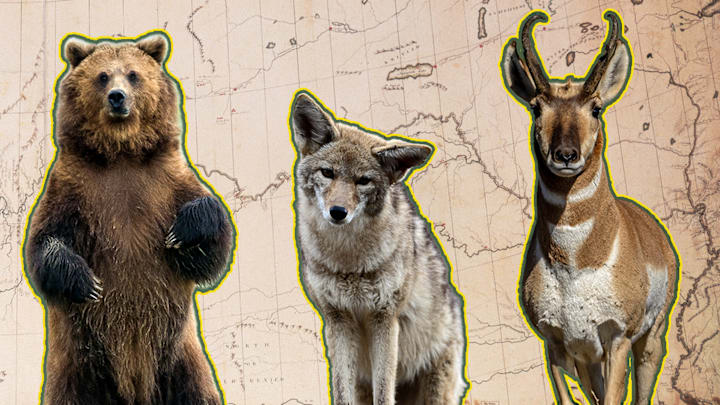Meriwether Lewis and William Clark were credited with discovering at least 178 plants and 122 animals during their great early 19th-century expedition across the North American plains. Although they were not the first people to lay eyes on the creatures, they did introduce them to Western science. Here are 15 of the animals Lewis and Clark described during their travels.
- Pronghorn
- Grizzly Bear
- Swift Fox
- Black-Tailed Prairie Dog
- White-Tailed Jack Rabbit
- Bushy-Tailed Woodrat
- Mule Deer
- Long-Billed Curlew
- Bison
- Elk
- Mountain Beaver
- Richardson’s Ground Squirrel
- Long-Tailed Weasel
- Sea Otter
- Coyote
Pronghorn

Among the many animals Lewis and Clark “discovered” during their expedition were pronghorns—also commonly called pronghorn antelopes, even though they aren’t actually antelopes but are instead the only member of the Antilocapridae family. Spanish explorers had likely alluded to these animals in the 16th century; well before they arrived on the continent, Native American peoples were hunting the pronghorn for food.
Grizzly Bear
Lewis and Clark first saw evidence of the mighty grizzly bear in 1804. They were in South Dakota, near the Moreau River, when they spotted paw prints in the mud. They went on to see—and kill—several of the enormous ursines throughout their journey. The Blackfeet Nation had long lived among the grizzly bear, which they called “kyaio,” before Lewis and Clark arrived. About a century after the expedition, nearly all of the grizzly bears were gone from the Midwest due to hunting and habitat destruction.
Swift Fox

The swift fox left Lewis and Clark a bit befuddled when they first came upon it. At the time, Lewis wrote that he did not know what the curious creature was—only that it was small and incredibly fast. Swift foxes, like so many other animals, suffered a major population decrease as European settlers spread westward. Some tribes began a five-year reintroduction process for the animals in 2020 to try to restore their populations.
Black-Tailed Prairie Dog

The prairie dog is one animal that Lewis and Clark not only cataloged, but also captured a live specimen of. They brought one back East to show President Thomas Jefferson. Clark described the animal as a “pleasing little critter.” Of course, Indigenous peoples in the Americas knew of prairie dogs before Lewis and Clark encountered them; the animals are called “pìspíza” in the Lakota language.
White-Tailed Jack Rabbit
One of the characteristics of the white-tailed jack rabbit that Lewis quickly noted was that it was “extremely fleet.” He thought it shared many characteristics with the European hare, and even dubbed it the “large Hare of America.”
Bushy-Tailed Woodrat
Lewis wrote that the bushy-tailed woodrat was “new to science” and that it looked like a standard rat with big ears. The rodents are also commonly called packrats, as they’ll collect a whole assortment of random items at their nests.
Mule Deer

Nebraska was the first place where Lewis and Clark encountered mule deer. Over the next eight months, Lewis saw so many mule deer that he wrote an extensive description of the animal, noting their black tails and that the ungulates appear to prefer a mountainous and rough environment. The deer are common out west, and are traditionally a source of food and hide for Indigenous people.
Long-Billed Curlew

Lewis and Clark noticed the long-billed curlew near Great Falls, Montana. The shorebird, known for its long bill and legs, migrates to the Great Basin and the Great Plains for the summer breeding season. The two explorers noted that it was unlike most of the other birds they’d seen.
Bison

Lewis and Clark initially noted bison tracks while in Missouri. Less than a month later, they saw the animals—which they erroneously called “buffalo”—for the first time. They would go on to encounter more, and even killed, salted, and ate the large animals. Bison are a traditional food source for several Indigenous peoples in North America; each described the beasts in their own language. The Blackfoot Nation word for bison is iinniiwa, the Lakota people refer to it as tatanka, the Navajo Nation call it “ivanbito,” and the Paiute know it as kuts.
Elk

Lewis and Clark came across an abundance of elk throughout their expedition—they killed 94 of them in the first year alone. The men used the ungulates for food and also made ropes and moccasins out of their fur and skin.
Mountain Beaver
In 1806 Lewis described an animal that was about the size of a squirrel, but with soft looking fur. He recorded that the Chinook and Clatsop People called the animal a sewelel. While it was eventually dubbed a “Mountain Beaver” in English, this animal is not actually a beaver, nor does it only live in mountains. Instead, it shares habits with the prairie dog and burrows in the ground.
Richardson’s Ground Squirrel
In 1805, Lewis wrote that his men brought him a rodent that was bigger and “handsomer” than the squirrels he had previously encountered. He noted its flat tail, red and brown coloring, and its tendency to burrow.
Long-Tailed Weasel
Clark made his first mention of a long-tailed weasel in November of 1804. Their pelts—which were either white in the winter or brown in the summer—were traded between Native American tribes and Western settlers.
Sea Otter

Sea otters didn’t appear in Lewis and Clark’s notes until February 1806. Lewis wrote that the coastal animals were about the same size as a common mastiff—or as he spelled it, mastive—dog. He also described its coat as “the most delicious fur in the world,” though he was undoubtedly describing its texture and color rather than its flavor.
Coyote

Lewis and Clark saw their first “prairie wolf” in August 1804. They encountered them again throughout their travels, noting their barks, bushy tails, and small, almost fox-like size. But these “prairie wolves” Lewis and Clark kept encountering were not actually wolves but coyotes, a name that evolved from the Nahuatl Mexican word coyotl.
Read More Stories About Animals:
